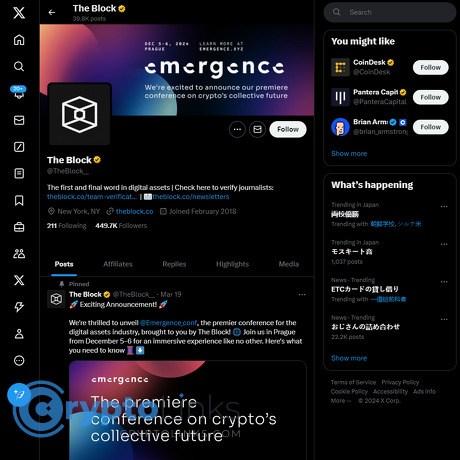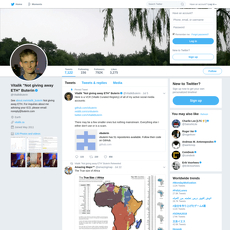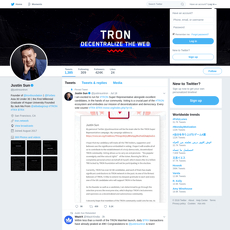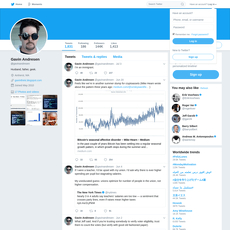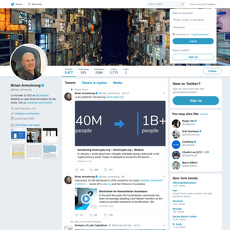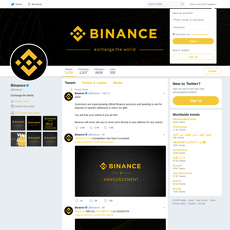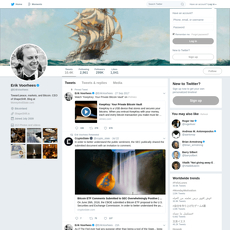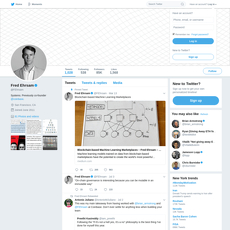The Block Review
The Block
x.com
The Block review guide: everything you need to know + FAQ
Want fast crypto news that’s actually right — and worth your attention? Or are you tired of chasing rumors and hitting paywalls that slow you down?
Describe problems or pain
Crypto moves at warp speed, and the news cycle can feel like a firehose. The result? You either miss the one update that matters or you sink hours into noise. A few real headaches I see every day:
- Speed vs. accuracy: Headlines hit X first, and corrections come later. That’s dangerous if you trade or make decisions in real time. Remember the October 2023 “BTC ETF approved” rumor that sent Bitcoin flying for nothing? That’s the kind of chaos we want to avoid.
- False news spreads faster: A well-known study in Science (Vosoughi, Roy, Aral, 2018) found false stories travel farther and faster on social networks than true ones. Crypto is especially exposed to this effect during breaking events.
- Paywall confusion: Some outlets mix free headlines with paid research. It’s easy to waste clicks or miss context if you don’t know which channel to follow for what.
- Name mix-ups: “The Block” is a media outlet. “A Bitcoin block” is a batch of transactions. Then there’s the TV show “The Block.” Search results get messy, feeds get noisy, and you can end up following the wrong thing.
- Feed overload: Following every outlet means duplicate headlines and notification fatigue. You need a way to catch the real scoops without drowning.
Bottom line: you want signal over noise, quick alerts that actually help, and a simple setup that doesn’t burn your attention.
Promise solution
I’ve tracked The Block for years — their scoops, corrections, and how fast they move — and I use them daily without getting spammed. I’ll show you how to do the same.
- How to follow @TheBlock__ on X the smart way, including when to turn on notifications and when to pause them.
- How to spot the headlines that matter (and skip the ones that won’t move markets).
- How to tell “we heard” from “it’s confirmed,” and what a solid correction looks like during chaotic cycles.
- How to avoid the “block” confusion entirely and find the right sources fast.
By the end, you’ll have a tight, 5‑minute setup that surfaces The Block’s edge — speed + sourcing — without wasting your time.
What you’ll get out of this guide
- A workflow, not just links: exactly where to follow, what to mute, and how to structure alerts so you don’t miss the real stuff.
- Clarity on formats: what The Block posts on X vs. what lives on their site vs. what’s behind a paywall — and how to choose what’s worth your inbox.
- Practical verification tips: quick checks with primary sources so you’re not trading on rumors.
- A plain-English FAQ: “The Block” vs. “a Bitcoin block,” block rewards, and other common mix-ups that clog search results.
Who this is for
- Traders and analysts who need early, accurate headlines and a clean way to filter noise.
- Founders and teams who want policy, venture, and infra updates without babysitting feeds.
- Crypto-curious readers who just want the key stories, fast, without subscribing to everything.
What this isn’t
- It’s not a list of every article The Block has ever published.
- It’s not a hype reel. I’ll point out where they’re great — and where you should double-check.
- It’s not another “top 10 news sites” post. This is a hands-on guide to getting value from one outlet, fast.
“Crypto rewards the first mover, but punishes the first wrong mover.” The fix is a simple system: follow for speed, verify for confidence.
Ready to see what The Block actually is, who it serves, and when it’s worth your attention? Let’s start with a quick snapshot — and I’ll show you how to avoid the common traps from day one. Shall we jump into what The Block is and who it’s best for next?
The Block at a glance: what it is and who it serves
The Block is a crypto-first newsroom and research shop that focuses on fast, sourced reporting. Think breaking headlines, quick-turn explainers, and paywalled research that tracks market structure, liquidity, and sector trends. It’s built for people who make decisions on short notice: traders, founders, analysts, and compliance teams. If you want headlines that hit before the market fully reacts—and enough context to decide if it’s noise or signal—this is the lane they try to own.
“In crypto, seconds are expensive. The first alert can save you money; the first read can save you hours.”
Quick history and reputation
The Block launched in 2018 and grew by being early on scoops and quick with explainers during chaotic moments. They earned a reputation as a “scoop-first” outlet by publishing sourced updates on exchange outages, regulatory actions, and funding moves while others were still aggregating tweets.
The big blemish: in late 2022, it emerged that a top executive had taken undisclosed financing connected to Sam Bankman-Fried’s entities. Leadership changed immediately, and the company installed stricter disclosures and separation between editorial and commercial teams. Today, they put more emphasis on sourcing, on-record documentation, and clearer conflict labeling—changes that matter when trust is your product. If you followed their feeds around the January 2024 spot bitcoin ETF approval or the November 2023 U.S. enforcement headlines, you likely saw fast posts with links to primary docs; that’s the kind of behavior pros expect post-2022.
What they publish (news, research, scoops, newsletters, podcasts)
- Breaking news and market alerts: Rapid updates on ETF filings/approvals, enforcement actions, exchange incidents, big token listings, and macro catalysts. Typical post includes a tight headline, a one-paragraph summary, and a link to a court filing, regulatory docket, or company statement. During the spot bitcoin ETF approval day (Jan 2024), their feed ran minute-by-minute posts with SEC links—exactly what you want when price is moving.
- Scoops and investigations: Reporter-sourced items on fundraising rounds, executive departures, product roadmaps, or internal memos before they’re public. Useful for getting ahead of sentiment shifts in specific sectors (L2s, RWA, restaking, stablecoins).
- Research (paywalled + some free): Sector reports, monthly/quarterly maps, and data snapshots on volumes, market share, fees, TVL composition, and venture flows. Good for a “what changed this month” digest without building your own dashboard from scratch.
- Newsletters: Daily or near-daily wraps, often split by “markets,” “policy,” or “builders”. If your inbox is sacred space, pick one that fits your role and treat it like a morning brief.
- Podcasts: Interview-driven shows with founders, market makers, and policy voices. Long-form context on how the people moving markets are thinking. Frank Chaparro’s conversations tend to be the flagship style: direct, market-relevant, and timely.
Why this mix works: speed for trades, documentation for trust, and research for context. Academic work has repeatedly shown that timely news can move prices within minutes (Chen, De, and Hu, NBER; Tetlock, RFS). In crypto—where information routes through social feeds first—the payoff for “fast and sourced” is even bigger.
Who gets the most value
- Active traders: Use the headline speed and the direct links to filings. Great for catching SEC postings, exchange status changes, and whale-size news before it’s fully priced. Look for phrases like “according to court filings” or “per a company statement”—those are tradeable crumbs.
- Compliance and legal teams: Their policy trackers and enforcement coverage are practical. During regulatory news hours, posts usually include docket numbers or PDF links you can log in your system.
- Builders and founders: Watch the scoops on infra launches, L2 migrations, bridge updates, stablecoin integrations, and venture rounds. Helpful signal on what customers and competitors will ask about next.
- Analysts and allocators: Pair headlines with their research snapshots to summarize market structure shifts (CEX vs. DEX share, perps vs. spot, LST/LRT flows). Good for monthly review decks.
- Casual readers: The recap posts and newsletters deliver the “only what matters” version of the day. It’s the easiest way to keep up without getting lost in threads.
What they’re strongest at (and what they’re not)
- Strengths: Speed, sourcing, and a knack for the “one paragraph that matters.” During volatile windows (ETF approvals, exchange settlements, major exploits), their feeds feel like a wire service for crypto.
- Not the goal: Hand-holding tutorials or deep quant backtests. Treat them as the “first touch,” then confirm with a primary doc or your favorite analytics tool.
Real-world moments that show their value
- ETF approvals and filings: Rapid cross-posts with links to the SEC’s site so you don’t trade on a screenshot.
- Regulatory actions: Timelines updated as orders, complaints, or settlements hit, often with excerpts you can copy into internal notes.
- Exchange or protocol incidents: Quick acknowledgement posts with status updates, then follow-ups as teams publish official notices.
If your heartbeat went up remembering any of those moments, you already feel why speed + documentation is the combo to look for. Now, the trick is using their channels without letting them run your attention.
Want a setup that surfaces only the alerts worth acting on—right on X and without feed clutter? I’ll show you exactly which handles to follow, how to build a clean List, and when to turn on notifications next.
Where to follow The Block (and how to actually use it)
I want fast, accurate crypto news without babysitting fifty tabs. Here’s how I set up The Block so it works for me in minutes a day, not the other way around.
“In crypto, minutes are money. Your feed either pays you or taxes you.”
X/Twitter: https://x.com/TheBlock__
The Block’s X account is their sprint lane. During major events (ETF headlines, exchange incidents, exploits), they post quick hits with sourcing, then link out to a full piece once details firm up. You’ll often see language cues like “BREAKING:”, “SCOOP:”, or “JUST IN:”—use those to triage what needs attention now vs. later.
Practical setup that actually works:
- Turn on notifications for @TheBlock__ only during market-moving windows (ETF decisions, CPI/FOMC days, major trials, big airdrops). Toggle them off after; protect your focus.
- Create a private List named “The Block – Core.” Add @TheBlock__ and their active reporters/editors. Easiest way: check the site’s About/Team page, tap through to their X profiles, and add them to your List. This cuts through retweets and memes.
- Use X Pro (TweetDeck) columns: one for your “The Block – Core” List, one filtered by keywords like
(SCOOP OR BREAKING OR SEC OR ETF OR exploit OR hack OR bankruptcy OR outage). This surfaces market-movers first.
- Mute duplication: on X, click the three dots on overlapping outlets and “Mute retweets.” You’ll still catch unique headlines from each source without the echo chamber.
Why this matters: when the SEC’s X account was compromised in January 2024 with a false ETF approval, BTC whipsawed within minutes. Outlets that flagged the hack quickly helped traders avoid getting chopped up. Social channels move the fastest—multiple studies and real-world tape show crypto reacts to platform headlines in minutes, not hours. If you trade, speed isn’t optional.
Website, sections, and newsletters
The Block’s site (start at theblock.co) splits into timely news, explainers, and paywalled research. Think of it like this:
- Homepage: best for a quick skim of what just happened and what’s rising. Open two to three tabs max—don’t turn it into a rabbit hole.
- Category pages (e.g., Markets, Policy/Regulation, Exchanges, DeFi, Venture): bookmark the two that match your role. Traders usually pick Markets + Exchanges; founders often pick Venture + Infra/Engineering; compliance folks pick Policy/Regulation.
- Free vs. paid: headlines and most breaking pieces are free. Deep-dive data notes and some research are paywalled. If you’re not paying, use the headline + first paragraph to decide whether to seek a primary source (company blog, filing, on-chain link) for the rest.
- Newsletters: keep your inbox lean. My rule of one:
- Daily Brief for a single morning scan.
- Markets if you want trading-relevant headlines with context.
- Policy/Regulation if you manage risk or work in compliance.
Subscribe to one now; add a second only if you actually miss things.
Inbox triage tip: set an email rule that stars any subject with “SCOOP”, “Breaking”, “SEC”, “ETF”, “Exploit”, “Outage”, or “Sanctions”.
Podcasts and RSS for passive consumption
If you prefer passive intake, their flagship podcast (search for “The Scoop” in your podcast app) brings industry operators, market makers, and founders into the room. Auto-download episodes and skim the show notes; if a guest mentions a listing, hiring freeze, treasury move, or a regulatory posture change, that’s often actionable context.
- Commute stack: 1x episode at normal speed for nuance; 1x newsletter skim when you park; star anything tied to your positions or pipeline.
- RSS/feed: if the site provides an RSS, drop it into Feedly and create priority rules for the same keywords above. No official feed? Use a page-watcher like Visualping on the homepage or category pages and set “contains” filters for hot terms (ETF, hack, exploit, lawsuit, bankruptcy, listing, delisting, halt).
When to check during market-moving hours
Crypto never sleeps, but newsmakers do. I time-checks around when regulators, courts, and exchanges are most active:
- EU morning (roughly 06:00–09:00 UTC): policy and exchange announcements often hit.
- US open (roughly 13:00–16:00 UTC): macro prints, filings, and enforcement updates land; liquidity wakes up.
- Asia session (roughly 23:00–03:00 UTC): exchange incidents, upgrades, and token announcements skew higher.
- Event days: CPI/FOMC, SEC/ETF deadlines, major trials, or big protocol upgrades—turn on @TheBlock__ notifications for the day, then off after.
If you’re actively positioned, add a lightweight “keyword watch” column in X Pro for your holdings or sector (e.g., “L2,” “staking,” “ETF flows,” “stablecoin bill,” “MEV,” “listing”). You’ll catch relevant headlines without doomscrolling.
How to avoid duplication if you already follow similar outlets
Seeing the same headline five times is how you miss the sixth one that actually matters. Here’s how I keep it clean:
- Separate speed vs. depth: one X List for “Speed” (The Block + reporters); another for “Depth” (long-form/research). Check “Speed” during the day; “Depth” once.
- De-echo your feed: mute retweets from overlapping outlets; keep original posts only. On X Pro, add a filter -filter:retweets to your List column.
- Keyword-triggered alerts: use Feedly Leo or email rules to only ping you for high-signal words (SEC, exploit, hack, bankruptcy, outage, ETF, approval, injunction). Everything else can wait.
- One-touch save: star/flag anything that mentions numbers (flows, AUM, volumes, exploits in USD) or direct sources (court docket numbers, on-chain tx links). Numbers and sources beat takes.
Real talk: you don’t need to read everything. You need to see the right thing first. This setup does that.
Now here’s the tension we all feel: fast is great, but can you trust it when it’s fast? What happens when a headline shifts mid-cycle or a source walks back a claim? In the next part, I’ll show you exactly how I gauge The Block’s sourcing, how they handle corrections, and when I wait for a second source before I act—want the checklist?
Can you trust The Block? My take on quality, sourcing, and speed
Speed matters in crypto. Miss the first credible headline and you’re chasing candles. But speed without accuracy is just noise. As I’ve watched The Block over the years—especially their X feed—one pattern stands out: they’re fast, often first, and usually anchored to documents, filings, or direct company statements. That mix is why pros still keep them in the toolkit.
“Fast is fine, but accuracy is everything.”
When the market is chaotic (exchange outages, enforcement actions, token exploits), their editors tend to publish quick headlines and then layer confirmations as the primary sources appear. That “iterate fast, cite faster” rhythm is the edge.
Track record and corrections
On balance, The Block’s track record is solid in high-signal moments—exchange policy changes, regulatory developments, and infrastructure updates. You’ll often see a short headline hit first, then a link to the underlying document within minutes. During big events, a single story can get several timestamps as more proof lands.
How they handle corrections is just as important:
- Clear labels: Look for “Update:” or “Correction:” at the top or bottom. A good fix states exactly what changed (e.g., wrong figure, misattributed quote, timing).
- Timestamps: Time-zone tagged edits help you track what the market saw and when.
- Linking the source: If a correction adds a court filing, company post, or on-chain link, that’s a strong sign they’re tightening accuracy, not smoothing over errors.
Real talk: being first has risks. A well-known example was the 2019 “Binance Shanghai office” story—The Block reported a police visit; Binance publicly denied the characterization. The Block stood by its reporting. Whether you agreed or not, it’s a reminder to respect uncertainty in the first hour of any “exclusive.” Smart readers weigh the wording, not just the headline.
In fast markets, “consistent updates” beat “perfect on first publish.” I’d rather see a developing article that graduates from “reportedly” to “confirmed” with a source link than a static post that ages badly.
Bias and conflicts to watch
Every crypto outlet has incentives. Ads, research subscribers, event sponsors, and industry relationships all create subtle gravity. The Block is no exception, and the 2022 funding controversy pushed them into stricter disclosures and leadership changes. That history matters because incentives leave fingerprints.
Here’s how I cross-check for bias without slowing down:
- Read the disclosure box: If there’s sponsorship, branded research, or partnerships, it should be visible. Treat glowing claims extra carefully.
- Watch the sourcing: Are quotes balanced across sides? If a story leans on “a person familiar” and lacks links to filings, wait for a second source before trading.
- Vendor data exclusives: If insights come from a data provider with a product to sell, I confirm with a second, neutral dataset.
- Language tells: Words like “plans to,” “exploring,” and “in talks” are different from “announced,” “filed,” and “launched.” Futures vs. facts.
Bias doesn’t mean “don’t read.” It means “read with your guard up when the story can move markets.” That’s how you stay fast and sane.
How I sanity-check their headlines without losing speed
When a The Block alert could impact price, I run a quick, repeatable playbook. It takes 60–120 seconds:
- Identify the claim type: Regulation, corporate action, hack/exploit, listing/delisting, policy change.
- Pull the primary source:
- Company posts: official blog or X handle
- Regulation/law: SEC EDGAR (8-K/10-Q), CFTC/DOJ press pages, court dockets (PACER; bankruptcy dockets via Kroll or Stretto)
- On-chain: Etherscan, Solscan, Blockchair; alerts from PeckShield, CertiK, or Arkham
- Exchange status: status page + official support account
- Match the verbs to proof: “Filed” = show me the PDF. “Launched” = live UI or code repo. “Seized” = agency notice.
- Scan the wording: “According to people familiar” = treat as directional; seek a second outlet (Bloomberg/Reuters/CoinDesk) or a company confirmation before acting.
- Use a two-source rule for trading: I trade on either a filed document or two independent outlets; I read the full piece for anything touching balance sheets, token unlocks, or solvency.
- For exploits: check the attacker address, confirm flow to mixers/bridges, and see if multiple security accounts agree on the root cause, not just the loss figure.
Why this effort? Because crypto reacts in minutes. Industry research and academic papers across the last few years consistently show abnormal returns clustering around credible, time-stamped news. If you can trim false positives without adding delay, that’s alpha.
Here’s what I’m watching for in their phrasing, especially when markets are jumpy:
- “Scoop:” Respect the edge, but assume a moving target. Expect follow-ups.
- “People familiar with the matter:” Could be accurate but fragile. Seek a document or a second outlet.
- “Confirmed/announced/Filed:” Strongest tier. Skim for the link to the primary source.
- “Plans/Exploring/In talks:” Optionality, not certainty. Good signal, weak trigger.
If you’ve ever chased a one-source rumor and got whipsawed, you know the feeling. I’ve been there. The way out is a simple habit: act on proof, observe the rest. It keeps you fast, not reckless.
One last tip: When The Block updates a story multiple times in an hour, read the latest paragraph, not just the headline. The newest line often flips the trade from speculative to actionable—like when a “reportedly paused withdrawals” becomes “confirmed by the company with a timestamp.”
So the obvious next question is: when should you pick The Block for speed and when should you lean on a different outlet for depth or datasets? And which combo actually saves time without missing key moves? That’s exactly what I’m comparing next—strengths, gaps, and the cleanest stack to run day to day.
When to pick The Block vs. alternatives
Here’s the simple truth I keep coming back to: The Block is my go-to for speed and scoops, but I never rely on any single outlet for conviction. Different jobs need different tools.
“In crypto, speed gets you in the room; verification keeps you in the game.”
That mindset matters because fast-moving headlines can be wrong, especially on social feeds. A well-known 2018 Science study found that false news spreads faster than true news on Twitter, and the 2024 Reuters Digital News Report shows trust remains fragile. That’s why I pair The Block with a few carefully chosen complements and a quick verification habit.
The Block vs. other outlets
- The Block — Best for speed, sourced scoops, and market-moving updates. During chaotic moments (think the SEC’s X account hack in January 2024 and the spot Bitcoin ETF approval window), their feed moved quickly and flagged corrections transparently. If you trade headlines or track dealflow, this is your first ping.
- CoinDesk — Investigations and court-docket rigor. They famously published the Alameda balance sheet piece that set off the FTX unraveling in 2022. If you want document-heavy analysis and bankruptcy progress, they shine. Slightly slower than The Block on pure breaking news, but excellent depth when it counts.
- Cointelegraph — Broad, global coverage and beginner-friendly explainers. They move fast, but verify before acting on market-moving CT headlines; you’ll remember the premature “ETF approved” tweet in October 2023 that markets reacted to before corrections followed. Use for breadth, not your only trigger.
- DL News — Strong on policy/regulation (especially EU) and DeFi investigations. When MiCA, stablecoin rules, or exchange compliance stories are heating up, I watch them closely. Less volume than The Block, more targeted watchdog energy.
- The Defiant — DeFi-native lens (protocol launches, AMM changes, governance spats). Great for understanding the “why” behind new primitives and token mechanics, plus a steady video cadence. If your world is DEXs and on-chain, you’ll get context you won’t see in headline-only feeds.
- Unchained — Interview-driven depth. Laura Shin’s conversations often surface the strategic layer you miss in day-to-day headlines: founder intent, regulator philosophy, and post-mortems. It won’t alert you first, but it will help you think clearly.
- Messari (research) — Sector frameworks, quarterly token and ecosystem reports, and long-form “Theses” pieces. Not a breaking-news tool; it’s your conviction builder. Perfect pairing when a The Block scoop makes you ask, “Does this matter in 3–12 months?”
- Kaiko (market data + research) — Liquidity, spreads, market microstructure. Their weekly notes and dashboards confirm whether a headline actually moved depth or was just noise. If you live by execution quality, it’s indispensable.
Who gets the most value
Traders: use The Block for first alerts; confirm with data before you click buy/sell.
- Alerts: The Block on X, plus notifications for a few reporters you trust.
- Confirm: Kaiko for liquidity/volume, and a price/volatility dashboard of your choice.
- Upgrade: When headlines mention filings or hacks, check a primary source (EDGAR, company blog, on-chain explorer).
Founders and BD teams: track competitor moves, listings, partnerships, fundraising.
- Scan: The Block for scoops and exchange updates.
- Context: The Defiant for product mechanics and user behavior in DeFi.
- Risk radar: DL News for compliance and regulator heat maps, especially in Europe.
Analysts and PMs: separate noise from signal and build theses.
- First pass: The Block for what just happened.
- Second pass: Messari for sector frameworks and quarterly tokens coverage.
- Proof: Kaiko for market structure; add an on-chain dashboard if token flows matter.
Compliance and legal: stay ahead of policy, enforcement, and counterparty risk.
- Monitoring: The Block for timely enforcement and exchange policy changes.
- Deep policy: DL News on EU items; subscribe to a policy-focused nonprofit like Coin Center for U.S. analysis.
- Documentation: CoinDesk often links filings and dockets when cases progress.
A simple stack that just works
- Speed: The Block for real-time headlines and early scoops.
- Depth: One research source (Messari if you want narratives and reports; Kaiko if you want market structure and liquidity views).
- Proof: One data layer (your preferred on-chain or market dashboard) to confirm impact.
- Policy: One policy newsletter (DL News policy or Coin Center) to catch regulatory landmines.
If you’re thinking, “Okay, but what about the word ‘block’ itself—how is that different from The Block, block rewards, ‘solving a block,’ and those random ‘BLOCK to BTC’ prices I see?” Great question—want the clean, no-BS answers next?
FAQ: quick answers and common mix-ups
I get the same questions every week—mostly because “The Block” sounds like a Bitcoin thing, and sometimes it is, but usually it isn’t. Here’s the quick, clean version so you don’t miss a beat (or a trade) over a name mix-up.
Is “a Bitcoin block” the same as The Block?
No—totally different.
- Bitcoin block = a batch of transactions confirmed by miners and added to the blockchain.
- The Block = a crypto media outlet that publishes news, research, and scoops.
Common tell: if you see “block time ~10 minutes,” that’s Bitcoin. If you see “The Block reports…,” that’s the media outlet.
How much Bitcoin is 1 block?
If you mean the Bitcoin block reward, it’s currently 3.125 BTC per block (after the April 2024 halving). Miners also earn transaction fees, which vary a lot.
- Base reward: 3.125 BTC (until the next halving, expected around 2028).
- Fees: anywhere from a fraction of a BTC in quiet periods to dozens of BTC during fee spikes.
Real example: at block 840,000 (the 2024 halving), fees surged to roughly ~37 BTC due to intense demand—fees alone massively outweighed the 3.125 BTC subsidy. Multiple on-chain analytics shops highlighted this spike as one of the largest fee blocks ever recorded.
Totally separate note: if you’re seeing “BLOCK to BTC” prices, that’s not a Bitcoin reward. It’s usually the token BLOCK (commonly associated with projects like Blocknet) trading against BTC—unrelated to Bitcoin mining or The Block media outlet.
How do you “solve” a block in Bitcoin?
Miners run a proof-of-work race. In simple terms:
- They assemble a candidate block header (includes the previous block hash, Merkle root of transactions, timestamp, difficulty bits, etc.).
- They tweak a nonce (and an extra nonce in the coinbase) and hash the header with SHA-256 twice.
- If the resulting hash is below the network’s difficulty target, the block is valid.
- That miner broadcasts the block; the network accepts it; the miner collects the block reward + fees.
The network adjusts difficulty every 2016 blocks (about two weeks) to keep average block time around 10 minutes. You’re not solving blocks with a laptop—this is ASIC territory.
Who are the sponsors of The Block?
This is where search results get messy. People often land on sponsor pages for the Australian TV show “The Block” (home renovation), which has totally different sponsors.
The Block (crypto media) runs ads and partnerships common in finance/tech. Look for clear tags like Sponsored, Presented by, or disclosure notes on articles, research, and newsletters. If you care about conflicts, check the site’s advertising or disclosures pages and the byline footers—those sections are where responsible outlets usually spell things out.
BLOCK token vs. Block, Inc. vs. The Block (quick sanity check)
- BLOCK (token): ticker used by some crypto projects (e.g., Blocknet). Trading pairs like BLOCK/BTC are just token prices.
- Block, Inc.: Jack Dorsey’s public company (ticker: SQ). Not a crypto token, and not The Block media.
- The Block: crypto media brand publishing news/scoops.
Three different things, similar names. When in doubt, check context: token charts vs. stock tickers vs. news headlines.
How many transactions fit in a Bitcoin block?
Bitcoin uses a 4,000,000 weight units limit (SegWit era), not a simple 1 MB rule anymore. In practice:
- Typical blocks hold roughly 1,500–3,500 transactions.
- If transactions are bigger (more inputs, non-SegWit), capacity per block drops.
- During busy periods, fees rise and the mempool backlog grows—miners prioritize higher-fee transactions.
Academic and industry measurements show modern block propagation across the network happens in seconds on average, which helps keep orphan rates low and supports the 10-minute cadence.
“Confirmed by The Block” vs. “block confirmations”
Two different meanings of “confirmed” can collide:
- “Confirmed by The Block”: newsroom context—reporters validated a claim with sources.
- “Block confirmations”: blockchain context—the number of blocks built on top of a transaction’s block (e.g., 6 confirmations ≈ strong settlement assurance for BTC).
How to cross-check a market-moving scoop fast
- Primary source: company or protocol’s official X account, blog, or press page.
- On-chain: for Bitcoin, confirm activity via mempool explorers; for EVM chains, check Etherscan-style explorers.
- One more reputable outlet: look for matching details or a direct source citation.
- Language cues: “reportedly” or “sources say” = early stage; treat position sizing accordingly.
Studies on news-driven returns show initial headlines can move price, while follow-up details often shift direction again. That’s why I keep alerts on—but I still wait for at least one hard source before sizing up.
Want my fast, no-noise setup to catch the right headlines without living on X all day? I’ll show you exactly how I do it—next.
Put it to work: my simple system for using The Block well
I keep this simple on purpose. In five minutes you can turn The Block into a clean, low-noise alert system that catches market-moving headlines without wrecking your focus. Here’s exactly how I run it day to day.
A fast, reliable follow setup
Follow the source and set smart alerts. Follow @TheBlock__. Tap the bell icon, but only turn on notifications during key windows:
- US hours: 8–11am ET on weekdays (macro, filings, enforcement, ETF updates)
- Asia hours: 7–10pm ET (protocol incidents, exchange updates, hacks)
- Event windows: FOMC, major protocol upgrades, court rulings, ETF decisions
When volatility is expected, alerts on. Otherwise, keep them off and check the feed on your schedule.
Build a tight X List for scoops. Create a private List called “Crypto: Fast Feeds” and add:
- @TheBlock__ (main account)
- Reporters you value: open a few recent articles on The Block, click the author bylines, follow those X accounts, and add them to your List. Keep it to 6–10 names so you’re seeing signal, not chatter.
Why this works: reporters often tease scoops or live updates before the main account posts. Lists cut out the rest of your feed’s noise.
Use X Pro (TweetDeck) like a radar. Add three columns:
- Column 1: Your “Crypto: Fast Feeds” List
- Column 2: A saved search for breaking phrases:
- "halts withdrawals" OR "suspends withdrawals"
- "files for bankruptcy" OR "Chapter 11"
- "SEC approves" OR "ETF approved" OR "ETF denied"
- "exploit" OR "hack" OR "bridge drained"
- "settlement with SEC" OR "SEC sues" OR "CFTC sues"
- "sanctions" OR "OFAC"
- "chain halt" OR "outage" OR "reorg"
- Column 3: Your personal watchlist keywords (examples below)
This setup catches both official headlines and the phrases that show up in early reporting. Research on real-time newsflow shows crypto markets react within minutes to verified events, and overreact to unverified ones—this radar helps you be early without being reckless.
Subscribe to just one newsletter (on purpose). Too many newsletters clog your brain. Pick one from The Block that fits your role:
- Traders: a daily recap with market movers
- Founders/infra: dev/infra and venture updates
- Compliance/policy: regulation and enforcement roundups
Everything else you’ll catch from your List + search columns.
Optional: route alerts to where you work. If your team lives in Slack or Telegram, use an RSS/automation tool to send The Block’s breaking posts (or your X List) into a single “alerts” channel. Keep it read-only to avoid chatter burying the signal.
Rule of thumb: if it can move a chart in under an hour, I want a push alert. If not, it can wait for the newsletter.
Sanity checks that save money
Fast is great; fast and verified is better. Here’s the two-step I use before I act on anything market-moving.
The “one primary or two-source” rule. I act only when:
- There’s a primary source (official filing/post) — or
- Two reputable outlets match on the same specific detail
Primary sources I check in 30–90 seconds:
- SEC/EDGAR and the SEC newsroom for ETF/settlement/complaint headlines
- CourtListener/RECAP for court filings if PACER is too slow
- On-chain explorers (Etherscan, Solscan, mempool.space) for exploits or large transfers
- Company status pages and official X/blog posts for exchange/protocol incidents
- GitHub releases and client repos for upgrade/bug notices
Remember the “SEC X hack” lesson. When the SEC’s X account was compromised and posted a false ETF approval, headlines and prices jumped, then whipsawed when the correction hit. A 30–60 second check of the SEC newsroom or EDGAR would have saved a lot of pain. Treat every “too good to be true” post the same way.
Note corrections. When The Block updates a story, I add a one-liner to my notes with the timestamp and what changed. If you trade on headlines, this habit pays for itself quickly.
Keep a short watchlist of topics you care about
Pick three topics, not ten. Add them as saved searches or X Pro columns. Examples:
- Bitcoin ETF — "spot bitcoin etf" OR "19b-4" OR "s-1 amendment"
- Stablecoin stress — "depeg" OR "redemptions paused" OR "reserve report"
- Exchange solvency — "halts withdrawals" OR "liquidity crunch" OR "proof-of-reserves"
- Solana reliability — "solana outage" OR "cluster restart" OR "congestion"
- L2 incidents — "sequencer down" OR "bridge paused" OR "fault proof"
- Enforcement — "SEC sues" OR "settlement with SEC" OR "CFTC complaint"
Then trim. If a search column doesn’t trigger useful actions for a week, kill it.
Micro-playbooks for common headlines
“Exchange pauses withdrawals”
- Check the exchange status page and official X
- Look for on-chain outflows or stuck transactions
- Decide on risk: reduce exposure first, post-mortem later
“Protocol exploited”
- Check Etherscan/Solscan for attacker addresses shared by reputable researchers
- Confirm with a security firm or the project’s post
- Avoid copycat phishing posts; wait for a signed message or repo update
“ETF decision incoming/posted”
- Check SEC.gov (newsroom and EDGAR) or exchange rule filings
- Expect fast moves; partial fills are normal if you wait for verification
Why this system works: you’re catching early signals (Lists + searches), but you only act on verified facts (primary sources or matched reporting). In 2024’s big moments—ETF decisions, enforcement actions, protocol incidents—this mix consistently beat scrolling aimlessly and cut false alarms.
Bottom line
The Block is excellent for speed and scoops. Pair it with a simple verification routine and you’ve got a dependable edge. Set up the List, the search columns, and one newsletter once, then toggle alerts only when it matters. You’ll catch the headlines that move markets without living in your feed.
Want this playbook handy? Bookmark this page on cryptolinks.com. If there’s a workflow you want me to add or you’ve found a smarter alert trick, ping me and I’ll test it and update the guide.
CryptoLinks.com does not endorse, promote, or associate with Twitter accounts that offer or imply unrealistic returns through potentially unethical practices. Our mission remains to guide the community toward safe, informed, and ethical participation in the cryptocurrency space. We urge our readers and the wider crypto community to remain vigilant, to conduct thorough research, and to always consider the broader implications of their investment choices.

